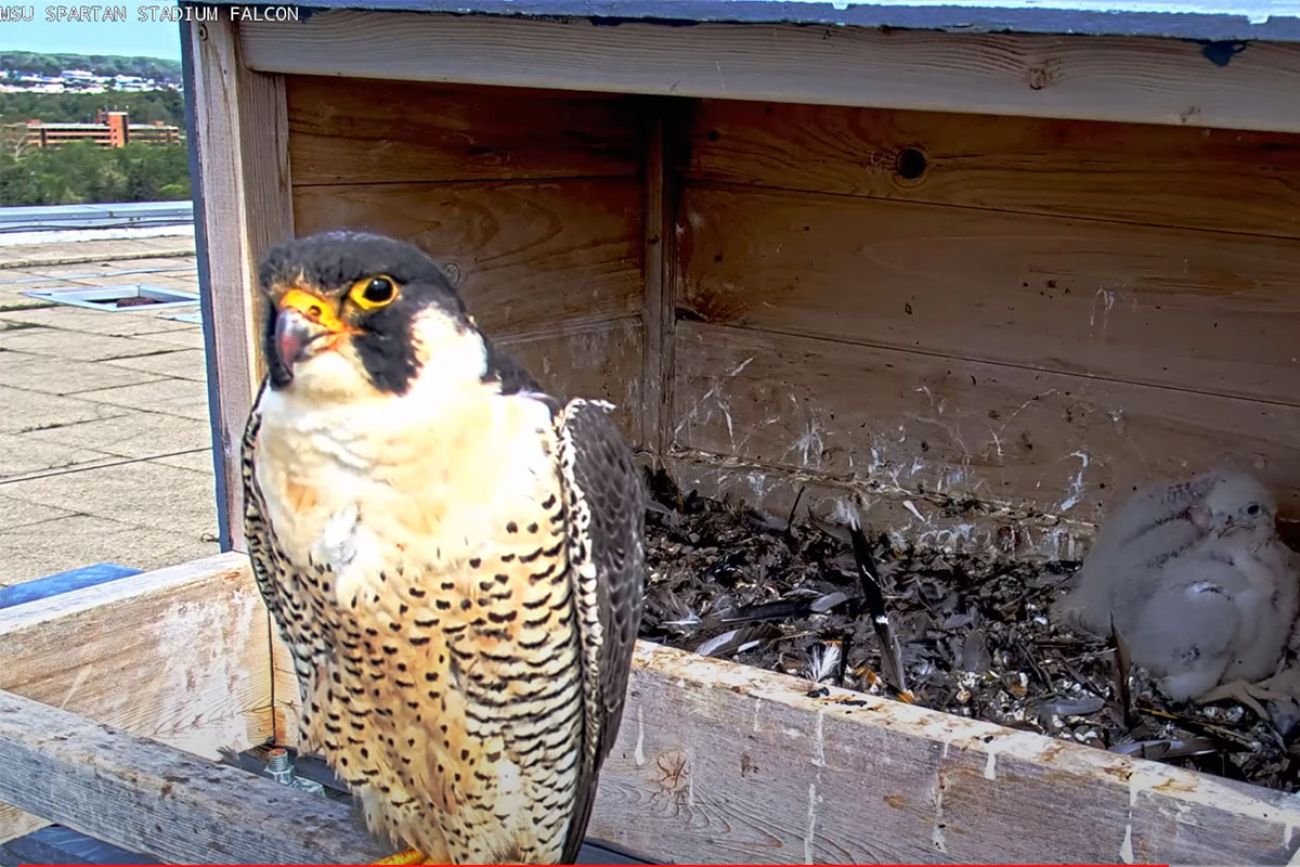Peregrine falcons make a comeback in Michigan. DNR ends banding program

- The Michigan DNR banding program for peregrine falcons, a state threatened species, is ending
- Banding and monitoring are efforts to recover the peregrine falcon population
- Peregrine falcons disappeared from the state in the 1960s because of DDT, a toxic pesticide
LANSING — On top of Spartan Stadium, a peregrine falcon family with three chicks lives in a nesting box, part of a statewide effort to rehabilitate peregrines in Michigan after pesticides decimated the birds of prey in the 1960s.
More than half a century later, peregrine falcons, the world’s fastest bird, have rebounded in Michigan.
At least two dozen active nesting pairs live in Michigan, according to the latest Michigan DNR report from 2019.
“They’re just an iconic species,” said Jen Owen, an associate professor in the Department of Fisheries and Wildlife at Michigan State University, who helped monitor the peregrines on Spartan Stadium. “It’s amazing to see this population recover.”

Their recovery is partly thanks to a two decades-old banding program run by the Michigan Department of Natural Resources that monitors the birds’ movement and health by attaching identification bands to their legs while the birds are still chicks.
But now that the peregrines are recovering, the DNR is ending its banding program.
Related:
- Sault Tribe restocks U.P. waterways with walleye, whitefish
- Wolves are hitting campgrounds on Isle Royale in search of food, park warns
- Birders flock to Lansing for urgent plea: Help before it’s too late
The banding program phasing out is good news, said Danielle Durham, a Michigan DNR nest coordinator for peregrine falcons in southeast Michigan.
“It’s been really successful. They’ve definitely overshot their (repopulation) goals,” she said. “We just don’t need to interfere anymore and can let them be wild.”
From the brink of extinction
Peregrine falcons are elite predators with dark blue-gray backs and white underbellies striped with black. The peregrine’s sleek, teardrop-shaped body can reach speeds up to 200 miles per hour while diving for prey.
Birders like Barb Baldinger of the Macomb Audubon Society look for adult peregrines’ distinctive hooked beak, yellow feet and stocky body to identify the bird.
Baldinger, who’s been a member of the Audubon Society since 1985, told Bridge over email that birders love spotting peregrines because they were once on the edge of extinction.
“To have completely lost our original population of peregrine falcons to the successful numbers of nests today is a wonderful success story,” she said.
Before peregines were a protected species, human activities like hunting, egg collecting and deforestation threatened the peregrine population.
DDT did the most damage.
The pesticide, used in agriculture and as a household bug repellant, weakened peregrine eggs. While keeping the eggs warm, the parents’ weight would crush the fragile shells and kill the chicks.
But how did the DDT get in the birds’ systems?
Peregrines would consume DDT, which is stored in animal tissue, while eating small birds that ate insects exposed to the toxic chemical. DDT accumulates in the bodies of animals, so at the top of the food chain, peregrines were getting hit the hardest by the toxic chemical.
It almost wiped the species out completely.
Before DDT, almost 4,000 nesting pairs of peregrines lived in the United States. Their numbers dwindled down to just 324 pairs in 1975.
They completely disappeared from Michigan and the eastern U.S.
Bringing back the peregrine
That’s when people started paying attention, said DNR nest coordinator Durham.
To protect the species from extinction, the U.S. Fish and Wildlife Service declared the American peregrine falcon endangered — and legally protected — in 1970, and the federal government banned DDT in 1972.
With nationwide recovery projects, such as captive breeding, and regulations on DDT use, peregrines made a comeback. In 1999, they were removed from the federal endangered species list.
But peregrines remained endangered in Michigan until last year when they were reclassified as ‘threatened.’
So Michigan has taken extra care to monitor its peregrine population.
The DNR monitors at least 25 active nest sites, human-made nesting boxes that mimic the rocky cliff faces peregrines typically call home. Most nesting sites are on tall buildings or bridges.
Every spring nesting season, peregrines return to their nests to lay three to four eggs. After the chicks hatch, covered in white down feathers, the DNR returns to band the surviving chicks, typically one or two.
“We wanted to band them so we can identify individual birds and keep track of survival rates,” said Sara Thompson, chief of the Michigan DNR wildlife division.
Styling a silver federal band on one leg and a colored band with an ID number on the other, the chicks shed their down feathers and leave the nest, watched by thousands of people around the world through live streams set up at each nesting box called ‘falcon cams.’
The livestream numbers are a testament to community support.
Thompson said the Michigan community is rallying around peregrines. So much so that even with the DNR ending its banding program, she said volunteer groups will surely continue monitoring the nests.
“Those groups are well established and are actually doing a majority of the work,” she said. “So all that monitoring work has not changed.”
What’s next
One of those nesting sites is at Michigan State University.
Since MSU started its peregrine nesting box on Spartan Stadium three years ago, it’s welcomed 10 peregrine chicks, all banded and monitored by the university with help from the DNR.
Even though the DNR is ending its program, MSU professor Owen said the university plans to continue banding and monitoring the peregrines born at the stadium.
With Owen’s banding permit, MSU Fisheries and Wildlife Club won’t need the help from DNR. And Owen said the nesting project will expand on current peregrine monitoring — studying their weight, size and migratory patterns.
“We can continue that (banding) process, but we will collect more data than has historically been collected by the DNR,” she said.
Students will analyze the data during the school year, learn about the near-extinction of the peregrine falcon and about one of the most successful recovery efforts in the world.
Michigan Environment Watch
Michigan Environment Watch examines how public policy, industry, and other factors interact with the state’s trove of natural resources.
- See full coverage
- Subscribe
- Share tips and questions with Bridge environment reporter Kelly House
Michigan Environment Watch is made possible by generous financial support from:
Our generous Environment Watch underwriters encourage Bridge Michigan readers to also support civic journalism by becoming Bridge members. Please consider joining today.
See what new members are saying about why they donated to Bridge Michigan:
- “In order for this information to be accurate and unbiased it must be underwritten by its readers, not by special interests.” - Larry S.
- “Not many other media sources report on the topics Bridge does.” - Susan B.
- “Your journalism is outstanding and rare these days.” - Mark S.
If you want to ensure the future of nonpartisan, nonprofit Michigan journalism, please become a member today. You, too, will be asked why you donated and maybe we'll feature your quote next time!






